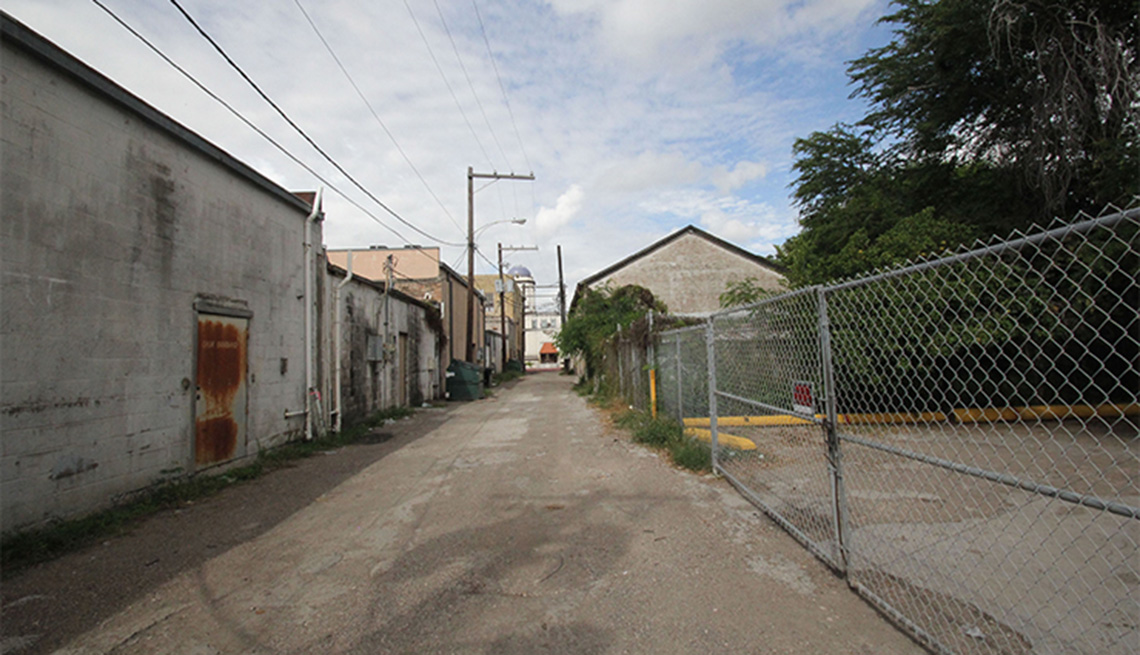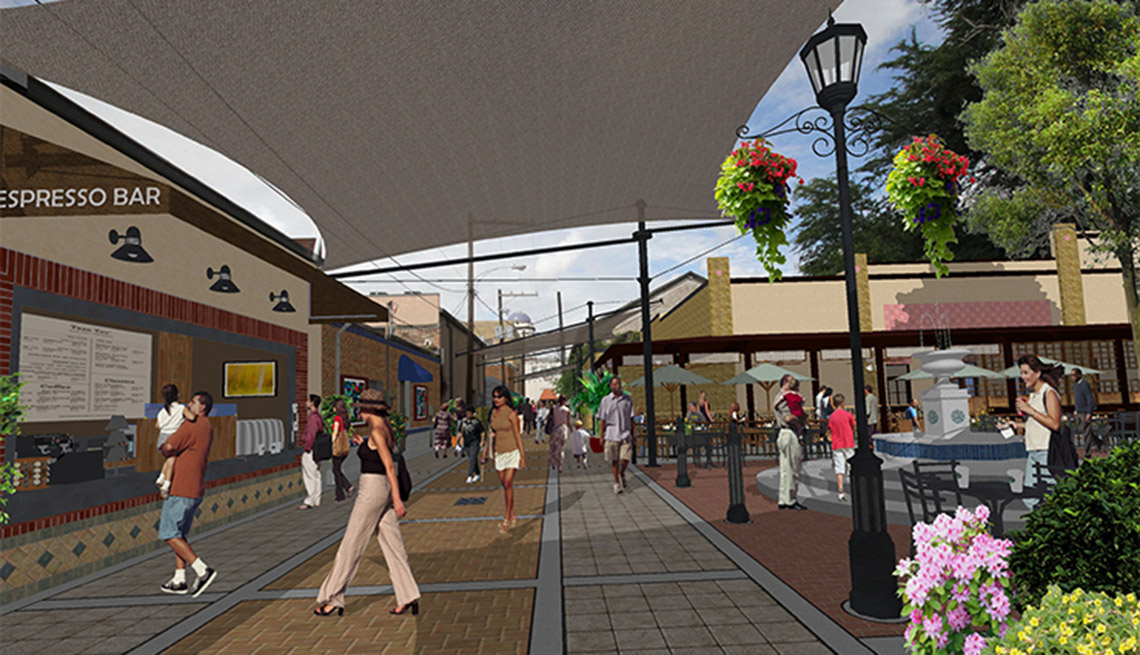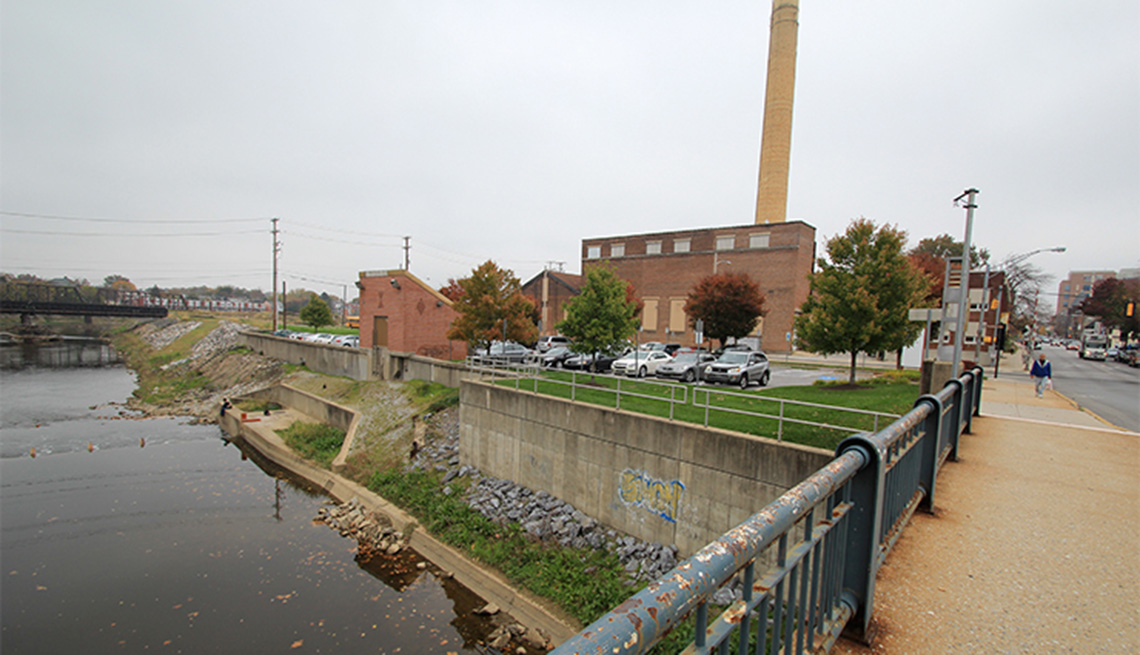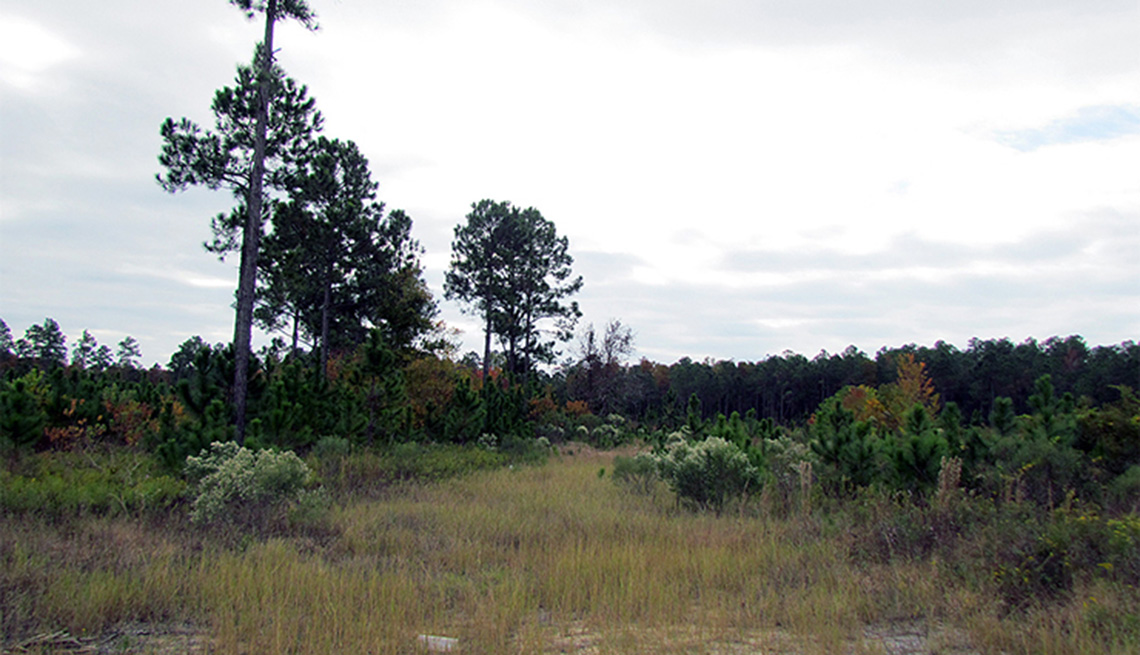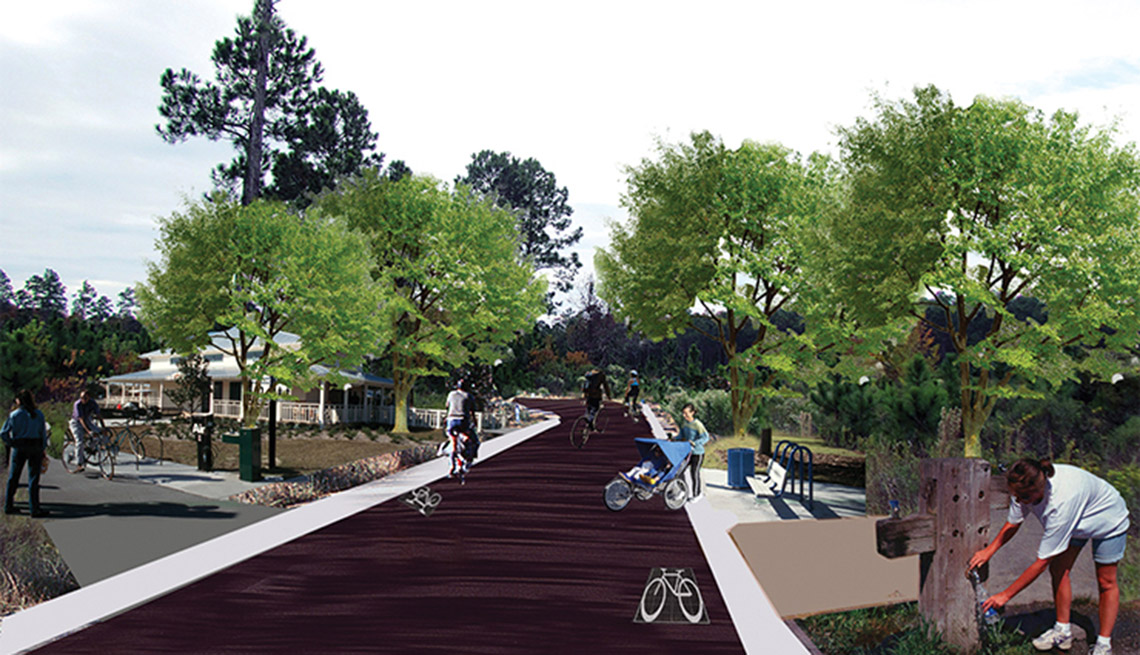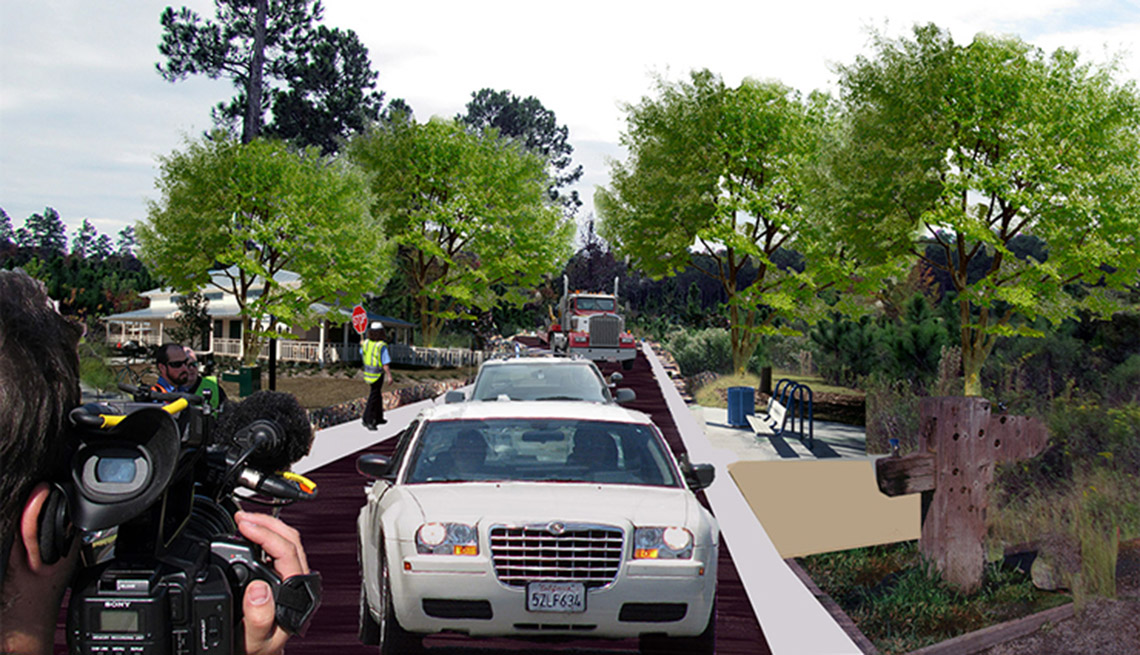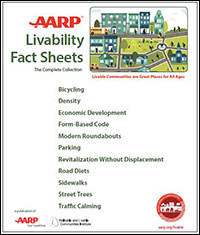Solutions for Back Streets and Underused Spaces
Four placemaking "photovisions" show how to enliven alleyways, shortcuts and desolate places
Editor's Note: The Walkable and Livable Communities Institute, AARP Livable Communities' partner in creating The Imagining Livability Design Collection, has closed shop. However, the 40-page publication the nonprofit helped develop in 2015 remains a valuable resource for communities and local leaders.
The transformations presented here show real locations as they appeared during visits by AARP and WALC between 2010 and 2015. WALC helped each community develop a vision for the future, and it created photovisions to reflect those changes and how each place could be made better.
1. Creating a Festival Street
BIRMINGHAM, ALABAMA
Powell Avenue in downtown Birmingham looks and feels abandoned due to high vehicle speeds, pedestrian unfriendliness and an expanse of stark and windowless buildings.
The Challenges
- Powell Avenue occupies most of an extremely wide right-of-way that has relatively low traffic volumes.
- The conditions encourage vehicle speeding and expose pedestrians to harsh, unsheltered conditions.
- A sidewalk is available on only one side of the street, which leads to pedestrians walking in the street or crossing the street twice to get where they’re going.
The Possibilities
- Powell Avenue becomes a festival street and destination.
- A gateway entrance creates a sense of arrival.
- The roadway accommodates the traffic flow and provides parking during work hours on weekdays, but it can be closed to vehicle traffic in the evenings, on weekends and during special events.
- The bold markings in the lane remind drivers to proceed slowly.
- The street entrance is drastically narrowed with curb extensions, which help calm traffic as it enters the street and makes for shorter pedestrian crossings.
- Seating and bike racks are abundant.
- New businesses and buildings enliven the area.
2. Bringing an Alley to Life
BROWNSVILLE, TEXAS
Like similar spaces throughout the country, Brownsville's downtown alleys are used only for parking and deliveries. Due to its location, this particular alley can connect the city's downtown to the University of Texas Brownsville.
The Challenges
- The alley space is downright desolate.
- What could be maximized as a great public space and connector is instead an undesirable, underused location.
The Possibilities
- The alley is an inviting linear plaza.
- The buildings are brought to life by property owners who see the potential for the space and, as a result, repair the backsides of their buildings.
- Exterior walls are transformed into murals featuring the work of local artists and young people.
- The fenced parking lot redevelops into a people-focused cafe and plaza.
- The impact of removing the off-street parking is offset by converting extra width in existing rights-of-way to provide on-street parking.
- Pedestrian-scaled lighting and shade help people feel welcome and watched over. (In the short term, a friendly police presence on foot or bicycle helps too.)
- As more people use the area, new private and public ventures emerge, such as a bicycle-share kiosk.
- Over time, building owners create new entrances and storefronts that turn toward the alley.
- Building transparency is high, with 70 to 90 percent of the ground-floor, outward-facing walls filled with windows.
- The surrounding area is primed for redevelopment, mixed-use buildings and a revitalized and more livable downtown.
3. Connecting the Community to a Key Asset
YORK, PENNSYLVANIA
Dormant spaces like this one in York can be redeveloped with a mix of land uses such as apartments, retail shops, a movie theater, cafes and offices. Improving conditions in this downtown location and maximizing the value of its creek will require long-term solutions. In the short-term, though, some simple changes can lay the foundation for long-term success.
The Challenges
- Little has been done to make people feel welcome or to capitalize on the placemaking and economic value of the creek.
- By failing to provide a vista or view, this side of the creek is making the other side of the creek less appealing, too.
The Possibilities
- While awaiting more significant redevelopment, such as a mixed-use development that celebrates and maximizes the value of the creek, work begins to build gathering places and a quality public space.
- The creek features a public walkway.
- The parking lot is replaced by a park.
- Extra width in surrounding streets is used as on-street parking to offset the removal of the parking lot.
- Placeless walls become murals featuring the work of local artists.
- A city-operated bicycle stand enlivens the space and makes people feel welcome and watched over.
- Public restrooms and wayfinding signage are provided.
4. Creating a Trail for Recreation and Evacuation
ORANGE BEACH, ALABAMA
By partnering with adjacent towns, the state government and federal agencies, the Orange Beach community has an opportunity to develop a national model for evacuation routes that are eco-friendly and support active living when not being used for an emergency evacuation.
The Challenges
- The pedestrian trail in this location is needed as a link from the beach to an expressway that is a key evacuation route during emergencies.
- The desire is to keep the trail’s use restricted to pedestrians and bicyclists while also having it be suitable for vehicles when needed.
The Possibilities
- The trail is 14 feet wide and built to support heavy loads.
- Most of the time, the trail is only for pedestrians and bicyclists and vehicles are prohibited.
- In times of emergency, the bollards preventing vehicle access are removed and the trail becomes a one-way route for vehicles during an emergency evacuation (as depicted in the photovision, below).
- As many as 14,000 vehicles can pass through the space in a 10-hour period.
- Once the evacuation is complete, the trail is used as a route to bring emergency supplies and goods back to the coastal area.
- After the disaster or period of emergency has passed, the bollards are reinstalled and the trail is once again used for recreation and active (non-motorized) transportation.
- To support this "Eco-Evac" trail, its termination point at the nearby intersection is a gateway with a single-lane roundabout that expands to two lanes during a disaster evacuation.
Our Other "Don't Miss" Resources Include
- AARP Livability Fact Sheet Series (pictured)
- AARP Livable Communities Slideshows
- AARP Livable Communities Interviews
- AARP Livable Communities How To's
- AARP HomeFit Guide
- AARP Network of Age-Friendly Communities
- AARP Livable Communities A-Z Archives
Stay Informed: Subscribe to the free, AARP Livable Communities Monthly e-Newsletter!
Stay Informed — For Free!
Featured Video
Learn how to check the "livability score" of any address in the U.S.
AARP.org/Livable
Enter a topic, name, place, etc.



